
35 minute read
Karel Appel
Christiaan Karel Appel was the son of a barber from the Dapperstraat in Amsterdam, and painted and drew from early childhood. He was naturally gifted and remained exceptionally productive throughout his life. Appel drifted around the Netherlands during the war; he painted landscapes and cityscapes and regularly attempted portraiture. In Amsterdam he attended classes at the State Academy where he met Corneille Guillaume Beverloo, a well-read young man from a well-to-do family from Haarlem. Corneille and the working-class Appel were intellectual opposites yet they soon became best friends. Appel first attracted attention in 1946 during the ‘Young Painters’ exhibition in Amsterdam’s Stedelijk Museum. This show also included Eugène Brands and Anton Rooskens but Appel and Corneille did not get to know them until some time later. An introduction to Constant resulted in the plan to set up an experimental group called Reflex. This led to the inauguration of the Experimental Group in Holland on 16 July 1948 and also involved Rooskens, Theo Wolvecamp and Jan Nieuwenhuijs. Appel wrote a manifesto that was rejected by the others. Instead Constant published his own manifesto in their ‘mouthpiece’ Reflex. Along with Constant and Corneille, Appel was there in Paris, at the founding of CoBrA in November 1948. Meanwhile Appel was working in the Netherlands on a commission that was to make him famous: a mural in the refreshment room of the Amsterdam city hall. The theme was ‘children asking questions’. However, their hungry faces encountered the resistance of the lunching officials. The mural was covered up following a great deal of fuss in the newspapers but by now the whole of Holland had heard of Karel Appel. The narrow-minded Netherlands soon became too small for Appel who felt the lure of cosmopolitan Paris. He moved there in the autumn of 1950 and found studio space in a deserted leather warehouse on the Rue Santeuil together with Corneille and a number of other artists. Appel’s international career soon took off. He exhibited with Martha Jackson in New York, and his work was also shown several years later by well-established art dealers such as Gimpel Fils in London and Rudolf Zwirner in Essen. Although his active and literary contribution to CoBrA was modest, nonetheless his work largely determined its image. As an artist, Appel remained as experimental as when he was a young man. He worked in an intuitive, spontaneous and expressive way and left his mark on every material he laid his hands on. [LvH]
Karel Appel, Kees van Bohemen, Corneille et al.
Advertisement
The Verweij Family Guest Book
1955–1960 paint, ink, pencil on paper 27.5 x 22.2 cm G/1409 donated by Mr. & Mrs. Verweij, 2002


details: This guest book belonging to the Verweij family of Schiedam has contributions by Karel Appel, Kees van Bohemen, Corneille, Jan Elburg, Lotti van der Gaag, Frits Klein, Jaap Nanninga, Lotte Ruting, Jan van Vlijmen, Emile Voeten, Theo Wolvecamp, Bouke IJlstra and others. The album also includes separate works consisting a drawing (1959), a hand-drawn New Year’s card (1958), and a photo of Lotti van der Gaag taken by Cor Dekkinga (1960), drawings by ‘J.C.A’ and ‘Koenig’ (1956), and an unsigned drawing on thin paper.

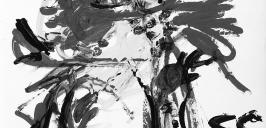




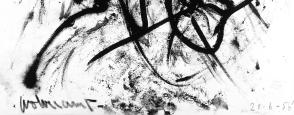






Portrait of a Gypsy Woman


1944 gouache on paper 67.5 x 54.5 cm S/11 purchased from Karel Appel, 1958
Sjaantje
1944 gouache on paper 74.0 x 54.5 cm S/43 purchased from Karel Appel, 1958
In 1944, Karel Appel was 23 years old and still at the beginning of his artistic career. He had already made portraits, a genre where he was not only quite proficient but was also able to earn some money. But these naturalistic portraits became a thing of the past once Appel left Amsterdam’s State Academy of Fine Arts in 1945. His work changed with this portrait of Sjaantje. Here, his aim was not to create an attractive likeness; the wrinkles, crow’s-feet and the hint of an incipient moustache are too mercilessly depicted for that. Sjaantje’s sharp features are well suited to an expressionist approach, which is further emphasized by the striking and colourful decorative background. The heavily accentuated contours and the head’s elongated form are strongly reminiscent of the work of the German painter Max Beckmann. Appel had fled the capital in 1944 and, together with Corneille, had found temporary shelter with a jewellery maker who lived on a boat on the Vecht. There, they were delighted to find copies of the French art journal Cahiers d’Arts, which was to influence the creation of the CoBrA movement. The reproductions of Beckmann were a real find and Appel studied them eagerly. By an irony of fate, Beckmann was exiled in Amsterdam at the very same time. Sjaantje is related to the colourful Portrait of a Gypsy Woman, another gouache dating from 1944 that is also a part of the collection (see page 29). [MdG]






Small Family Group
1945 gouache on paper 30.8 x 24.2 cm S/17 purchased from Karel Appel, 1958
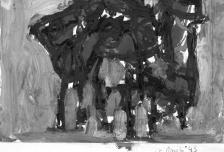
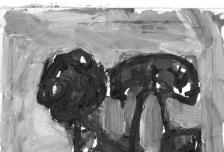


Head
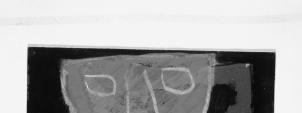
1945 watercolour, chalk on paper 29.7 x 21.7 cm S/35 purchased from Karel Appel, 1958

Fish and Bird
1946 gouache on paper 48.3 x 66.7 cm S/26 purchased from Karel Appel, 1958
Small Man with the Sun
1947 watercolour, chalk on paper 44.0 x 55.6 cm S/12 purchased from Karel Appel, 1958
Like Organ Grinder (see p. 36-37), Small Man with the Sun is one of the first examples of the passion for experimentation that inspired Appel after the end of the Second World War. It already includes a hint of Cubism and African Art. The primitive faces and the dissected and playfully re-assembled image combined with their touchingly mythical character, form an unaffected and particularly spontaneous depiction of a sense of reality. Both gouaches attest to an intense awareness of the moment. Appel’s wartime work was still reminiscent of Van Gogh, Breitner and Werkman. But he abandoned this Amsterdam and French Impressionist approach after the war, and allowed himself to be seduced by the work of Picasso and the savoir vivre of Miró’s oeuvre, which he had discovered through Constant. Small Man with the Sun is remarkable for its lightness of colour in the interplay of the virtually monochrome areas of its accentuated contours. The staging of the small man with his toy car and toy sun makes this depiction look like a child’s drawing. The grotesque and clumsy figures, which Appel turned into a new genre throughout that year, gaze at the viewer with a quizzical and innocent expression. Appel used this childlike innocence to disguise his pent-up artistic and social discontent. [KF]
Organ Grinder
1947 watercolour, pastel on paper 43.8 x 55.7 cm S/28/1-2 purchased from Karel Appel, 1958
details: on the back is a drawing of a female nude in red chalk.
This gouache of an Amsterdam organ grinder dates from an important period in Appel’s work that occurred right after the Liberation. In the years 1947 and 1948, he was making an increasing effort to free himself from what he described as ‘two thousand years of Europe’. He became acquainted with the École de Paris during a short visit to Paris, and he was also inspired by the first exhibition of Picasso and Kurt Schwitters in Amsterdam’s Stedelijk Museum, which was currently under the impassioned leadership of Willem Sandberg. A number of oil paintings and gouaches by Appel were shown at the ‘Young Painters’ group exhibition, which was also held at the Stedelijk. All the gouaches that date from 1946, 1947 and 1948 are experimental. It was a time of searching where Appel, like so many young painters, had fallen under the spell of not only Picasso but also Matisse and the young French painter Pignon. Organ Grinder even seems to have been influenced by the work of Dubuffet. But despite practising all the latest European styles, the subject matter could hardly have more typical of Amsterdam than this organ grinder. Amsterdam is the city of Appel’s youth and of his early years as a painter. He did not have a penny to his name but was completely happy in his first studio on the Oudezijds Achterburgwal. [KF]
Grey Forms in Blue
1947 ink, gouache on paper 35.3 x 54.3 cm S/34/1-2 purchased from Karel Appel, 1958
details: recto on the back is a fragment of an abstract composition in yellow, green, blue, purple, grey and off-white.
Grey Forms in Blue is an attractive experiment with materials. Appel clearly created his figures by applying a series of layers. The composition has been brought into balance by covering the form with a final layer of grey so that the blue and purple colours can come into their own. In some places, the gouache is so thick that it has begun to crumble and bits of paint have been lost. There is an even wilder experiment on the back of Grey Forms in Blue. Here, Appel apparently began a painting in Indian ink, over which he added green, yellow and a blue border. Purple paint was then dripped across it, which did not adhere to the yellow and green. The blue border has also been outlined in an off-white, opaque watercolour. The original painting – on what is now the back of this work – was once much larger: Appel later divided the sheet into four. [LN]
verso
Red Cubist Figures
1947 gouache on paper 48.8 x 64.5 cm S/31 purchased from Karel Appel, 1958
Three Heads
1948 gouache on paper 34.3 x 50.0 cm S/13/1-2 purchased from Karel Appel, 1958
details: on the back are black abstract signs against a red background.
Fish between Flowers
1948 gouache on paper 49.2 x 63.9 cm S/14 purchased from Karel Appel, 1958
After visiting Paris with Corneille in the autumn of 1947, Appel wrote him a short but badly-punctuated letter at the beginning of December:
‘Corneille Just writing to you, I’m working day and night I’ve just started painting now. I suddenly found it (at night) I’m now making a powerful primitive work more powerful than Negro Art and Picasso – Why, because I’m building upon the 20th century am a product of a Picasso Brightly Coloured I have broken through, through the wall of Abstract, Surrealism etc. My work contains (…) everything You mustn’t be pigeon-holed. Won’t come for the time being, no time work hard, throw everything overboard. Your friend Karel.’
The childlike figures, which were created at the end of 1947, acquired bright colours the following year. The reckless brushwork in Fish between Flowers shows that Appel used the medium of gouache so as to give vent to his passion for experimentation. His work of 1948 displays many variations in style ranging from children’s drawings, to which this gouache has the closest affinity, to items of rubbish and humorous fantasy creatures. All in all, it is clear that the artist Karel Appel has left academicism and the Impressionist tradition far behind him. Despite losing his studio at the beginning of 1948 and living like a tramp on the street, his production for that year was extremely high. [KF]
Eyes, Blue, Red Eyes Eyes
The most striking aspect of these three strongly related gouaches, which were all made in the same year, is their hushed atmosphere. There is none of the confusion of scratches, marks and smudges that are so typical of most of Appel’s works from these years. A virtually monochrome painted surface, which has been constructed out of a number of coloured layers, encloses several figures. The word ‘enclose’ is used intentionally here because it is obvious that the figures were painted first and then the surroundings. The top layer of paint leaves only an edge open around the figures. If you look more closely, you will see that the surface of paint around the figures is thick, and consists of many layers of paint. This suggests that the gouaches were initially far less restrained, and that there were probably additional depictions around the visible figures. These depictions were apparently later erased and covered with paint. Indeed, we know that Appel often worked in this way, and this technique can also be seen in other works (see p. 38-39). Hence, the hushed atmosphere of these gouaches is a conscious choice; the maker has imposed silence on his initial painting so as to stop at these few figures. The figures are eyes, according to the title, but they look much more like rudimentary human figures or animals. However, they could also be symbolic signs or letters from some strange alphabet, the meaning of which has been silenced. [PvU]
Eyes, Blue, Red
1948 gouache on paper 33.0 x 49.0 cm S/15 purchased from Karel Appel, 1958

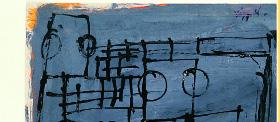

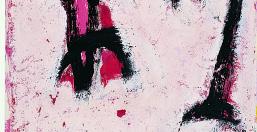




Eyes
1948 gouache on paper 49.8 x 29.8 cm S/32/1-3 purchased from Karel Appel, 1958
details: on the back is a grey background with a linear composition of stylized human figures. This is probably a variation on ‘the prisoners’ motif.
Eyes
1948 gouache on paper 33.6 x 45.4 cm S/33 purchased from Karel Appel, 1958
Rearing Animal
1948 watercolour, ink, chalk on paper 53.9 x 46.7 cm S/16 purchased from Karel Appel, 1958
Appel’s feet left the ground both literally and figuratively in Rearing Animal. This grotesque fantasy creature seems to be dancing in space because the top and bottom of this work are virtually interchangeable. Appel once said that at the beginning of his career he used to work in the dark. He had no light and no gas:
‘At that time I kept my gouache in jars. I knew roughly where the red, the blue, the yellow, the green and the black all were and I painted in the dark on cardboard. [...] It all became virtually abstract. [...] Then I put the light on, a candle, and picked it up and turned it around because I couldn’t see the top or the bottom. I finished them off in my own way, by covering them with an extra bit of white or by adding a red mark. If a sheet got dirty, I turned it into a red mark and then it was finished so far as I was concerned.’
During this period, Appel also made objects from rubbish that were inspired by the work of Kurt Schwitters. He found his materials amongst the garbage that had been left on the street. Yet painting was always Appel’s first love and he said that it helped him to come closer to the imagination. For him, Expressionism, as he called it, was an attitude rather than a technique: ‘You come with your daubings, and you begin with nothing and you end with nothing. But in the combination of all those daubings that go from nothing to nothing, “in between”, you feel a head or an expression: a sentiment.’ [KF]





Colour
1948 gouache on paper 50.5 x 20.5 cm S/19 donated by Karel Appel, 1956

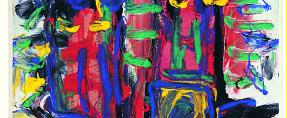








Passing Animals

1948 gouache on paper 49.0 x 63.5 cm S/24 purchased from Karel Appel, 1958
Standing Figure
1948 gouache on paper 48.5 x 20.5 cm S/92/1-2 donated by Karel Appel, 1956
details: on the back is a fragment of a composition in blue and black.
Rectangular and round forms have been woven together in Standing Figure, which can be read both from the front and from the side. Karel Appel may have observed this method in the work of Picasso, who was a source of inspiration for many artists after the Second World War. Appel regularly used these playful alternations in other work. Standing Figure displays a working method that is contrary to the process of covering the form in Eyes (see p. 44-47). The structure of white lines effectively highlights the figure against the rich colour nuances of the background. A typical CoBrA creature is depicted on the back of this work: a figure which, depending on the individual imagination, represents a standing figure, a bird or an insect. Appel began this sketch by painting the paper in blue and purple rather than by first drawing the form in ink. This imbues the paper’s surface with an imaginary space in which the drawing of the figure appears to float.
[LN]








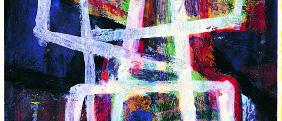



Animal under Stars
1949 ink, pastel on paper 38.2 x 45.8 cm S/25/1-2 purchased from Karel Appel, 1958
details: on the back sketch in ink.
Right after the CoBrA group was set up in November 1948, Appel, Corneille and Constant were invited to participate in an exhibition of the Høst artists association in Copenhagen. They were received with great hospitality: there was a delicious dinner and a great deal of discussion about each other’s work. Corneille wrote enthusiastically to his family:
‘[...] the painters are one big family wherever you go, all over the world. [...] there are emotions in life that are remembered forever and that was how the first glimpse of these paintings felt. Almost without exception, the proof of the vitality of their art was on the walls of this pavilion. Here, horizons open up to a better future.’
The Danish artist Carl-Henning Pedersen clearly had a particular influence on Karel Appel’s work. The humour and pleasure of Appel’s mythical animals disappeared and made way for a touch of abstract indignation. Animal under Stars dates from the same time as Children Asking Questions, a mural in the refreshment room of Amsterdam city hall that caused so much commotion amongst the officials that the painting was covered up. This gouache addresses the same lost and neglected reality as the piercing eyes in the mural and, like Children Asking Questions, it also has a compassionate quality. [KF]
Flying Bird
1949 gouache on paper 45.0 x 59.6 cm S/23 purchased from Karel Appel, 1958
details: on the back is a depiction of a bird in a landscape featuring a tree.
Two Figures, Dog
1949 gouache on paper 45.5 x 59.2 cm S/30 purchased from Karel Appel, 1958
Owl Animal with Bird Beak Sitting Bird
The chalk drawing Sitting Bird from 1950 has an obvious connection with two other drawings in the collection: Owl and Animal with Bird Beak (both from 1949). In these works, the influence of the Danish experimental artist Carl-Henning Pedersen can be seen in the scratched lines inside the contours. Pedersen scratched into the gouache or the painting with the back of his brush and Appel adopted the same technique. This Sitting Bird emerges from a grey background, an approach that was first used in 1948. It accentuates the world’s incomprehensibility. The work has the same attitude as Animal under Stars from 1949 (see p. 54-55). But there is also a small difference. The bird animal is not only piteous, like the sad animal beneath the starry sky, it also has something proud, something irrepressible. This animal is aware of itself. The innocent and humbled look of both Animal under Stars and Appel’s famous Children Asking Questions has made way for a single eye that stares critically sideways instead forwards and towards the viewer. This emphasizes reticence and reflection rather than a sense of spontaneity or direct experience. [KF]
Owl
1949 chalk, gouache on paper 43.7 x 53.0 cm G/71 purchased from Karel Appel, 1958
Animal with Bird Beak
1949 chalk, gouache on paper 41.0 x 44.5 cm G/100 purchased from Karel Appel, 1958
Sitting Bird
1950 pastel, gouache on paper 50.0 x 52.0 cm S/27 purchased from Karel Appel, 1958
Primal Animal
1951 oil on linen 90.5 x 114.3 cm S/49/1-2 purchased from Karel Appel, 1955
details: on the back is a depiction of a nude lying down (damaged) (see p. 64).
Appel adopted a painting method in the years 1950 and 1951 where he consciously assembled big, compact areas of colour. Primal Animal consists entirely of powerful touches such as colour, a black line or a thick, coloured contour. After the spontaneous gestures of the earlier work, Appel was to become the epitome of caution at the beginning of the 1950s. At this time he was living with Corneille in Paris, where he had a studio in an old warehouse on the Rue Santeuil. Life was anything but easy for them: sometimes they did not even have the money to buy oils, linen and brushes. Remarkably, it was under these circumstances that Appel discovered the importance of paint mass. He wrote in a letter to Aldo van Eyck:
‘Achieving matter is the new way for painters, architects etc. My work is changing dramatically. Recently in my Amsterdam studio, the creatures begin to emerge, I painted over all those canvases that I brought with me. It’s matter itself. [...] now I paint marks larger marks colours endlessly over each other remove and new colour marks until a concentrated area remains free and yet restrained suddenly a bright red or yellow and canvas and creature are caught in one.’
This work has striking similarities with Carl-Henning Pedersen’s oeuvre both immediately before and at the beginning of the Second World War. [KF]







Animal

1951 gouache on paper 47.0 x 71.0 cm S/22 purchased from Karel Appel, 1958

Animal

1953 gouache on paper 51.0 x 65.6 cm S/38 purchased from a private owner, 1957
The Wild Boy
1954 oil on linen 195.3 x 113.7 cm S/3 purchased from Karel Appel, 1956
Gone are the heavy contours and the smooth, neat and uncomplicated coloured areas of red, yellow, blue, green and black that typified Appel’s work of the previous few years. By 1954 Appel was painting with increasing ease. He no longer modified his paints, which were applied directly from the tube. He painted with big gestures and could turn his hand to large sizes. He proves himself to be a master of materials in The Wild Boy. Here, the observation in a letter to his architect friend Aldo van Eyck that ‘canvas and creature are caught in one’, is more true than ever before. The paint has been applied wildly across the entire canvas and bursts out of the form. Eyes, nose and mouth acquire a savage expression through an aggressive use of paint. [KF]








Untitled
1948 painted plaster h. 105.0 cm P/117 donated by Mr. & Mrs. Sanders, 1968
According to an interview with Karel Appel in 1990, making sculpture was always less important to him than his ‘first love’: painting. This statement is certainly borne out by his oeuvre: there are far fewer sculptures than paintings, and moreover almost all of them involve painting. Appel had become acquainted with the modern-classical sculpture of artists such as Picasso and Matisse immediately after the war. By 1947 he had began to experiment with assemblages made of a variety of materials that he collected on the streets of Amsterdam. The examples of these works that have survived consist of distinctly rectangular and crude forms, which are further accentuated by being painted in strongly contrasting colours. However, the plaster-covered constructions involve far more flowing and organic shapes, such as this wall sculpture from 1948. A figure has been created out of elongated, curved threads, which look as if they are made of dough. It is neither a human being nor an animal; rather it is a strange and fabulous creature with characteristics of both species. Its upright posture makes this creature look human but its legs vanish into a curve that contains the form of an animal; its arms turn into what look like antlers. The paint has been strikingly applied in primary colours: black, white, yellow, red and blue. This use of colour dates from De Stijl, an art movement with ideas that directly contradict Appel’s own theory of art. [PvU]





Untitled
1954 cotton 26.0 x 18.0 cm K/103/1-12 [shown only in part] donated by NV Stoomweverij Nijverheid Holland, Enschede, 1954


details: 12 samples of printed cotton designed by Karel Appel and produced by Stoomweverij Nijverheid Holland of Enschede. Three samples are identical to the inventory numbers K/217, K/218 and K/219.

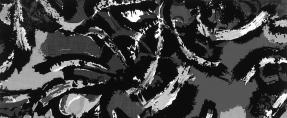

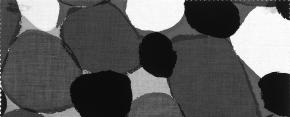


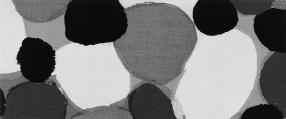

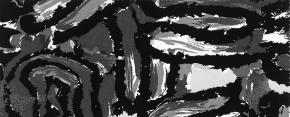







Untitled

1954 cotton 500.0 x 92.0 cm K/217 donated by NV Stoomweverij Nijverheid Holland, Enschede, 1954

details: remnant of printed cotton designed by Karel Appel (pattern number 26/9193/2) and produced by Stoomweverij Nijverheid Holland of Enschede.
Untitled

1954 cotton 462.0 x 92.0 cm K/218 donated by NV Stoomweverij Nijverheid Holland, Enschede, 1954

details: remnant of printed cotton designed by Karel Appel (pattern number 28/9194/5) and produced by Stoomweverij Nijverheid Holland of Enschede.
Untitled

1954 cotton 500.0 x 92.0 cm K/219 donated by NV Stoomweverij Nijverheid Holland, Enschede, 1954

details: remnant of printed cotton designed by Karel Appel (pattern number 26/9193/3) and produced by Stoomweverij Nijverheid Holland of Enschede.
Untitled

1954 cotton 800.0 cm x 92.0 cm K/220 donated by NV Stoomweverij Nijverheid Holland, Enschede, 1954

details: remnant of printed cotton designed by Karel Appel (pattern number 29/9192/2) and produced by Stoomweverij Nijverheid Holland of Enschede.
Sheet of Studies
undated ink, watercolour on paper 66.8 x 49.5 cm G/81 purchased from Karel Appel, 1958
The viewer’s attention is initially drawn to the centrally located figure. However, this sheet of studies is particularly interesting in terms of the small figures grouped around it that provide insight into the playful way in which Karel Appel familiarized himself with Picasso’s visual language. This applies explicitly to the middle drawing on the upper edge. Ethnographic art was another important stimulus for his experiments, a fact that is reflected by a sketch of a primitive mask on the right-hand side of the sheet. The central figure, which consists of robust lines in Indian ink, is reminiscent of both a primitive object with nails and the painted wooden sculpture that Appel assembled from driftwood and nails in 1948. Some fragmentary sketches can also be seen beneath the large composition. This sheet of studies provides us with a glimpse of the artist’s working process. We know that in 1947 Appel was exploring the motif of ‘prisoners’ in a series of works on paper. But this little man, with his mouth and eyes so emphatically open and his arms and hands spread in what looks like a plea for help, also refers to the ‘questioning children’ motif. During his train journey to Copenhagen in 1948, Appel passed through Germany and was struck by the misery of children begging for food on station platforms. On a number of occasions, he incorporated this theme into wooden reliefs and drawings. The most sensational example is the 1949 mural in the refreshment room of Amsterdam city hall. This sheet of studies probably dates from 1947–1948.
[MdG]





Small Child with Flowers
1947 chalk, watercolour, ink on paper 44.6 x 53.5 cm G/80/1-2 purchased from Karel Appel, 1958
details: on the back are sketches of fantasy animals in black ink.
Small Child with Flowers is a good example of Karel Appel’s interest in the simplicity of children’s drawings. An oval with two dots can easily be read as a face. The rectangular form beneath the oval is the body so that the image of a child is almost automatically created. Giving your imagination free rein can transfer the round circles next to the head into flowers. Appel concealed the paper’s hard tone beneath the poetic colour surrounding the figure; he depicted the child’s fantasy world and the viewer is encouraged to enter it. On the back of Small Child with Flowers are the forms and lines that Appel typically used for his fantasy animals. He created creatures by adding just a dot, a line or a shaded area to ovals, rounded rectangles or triangles. Between 1948 and 1952, Appel used these figures for decorating invitations and book covers and as illustrations for texts by his friends the writers Bert Schierbeek (Het bloed stroomt door [The Blood Flows On] p. 82), Hugo Claus (De blijde en onvoorziene week [The Happy and Unforeseen Week]) and Hans Andreus (De ronde kant van de aarde [The Round Side of the Earth] p. 81). [LN]
Figures in the Wood
1949 chalk, watercolour on paper 46.4 x 62.8 cm G/82 purchased from Karel Appel, 1958
Karel Appel’s work in the collection of the Stedelijk Museum Schiedam was only signed and dated some years after it was made. We know this for reasons including the fact that he sometimes added his signature across a damaged area. In many cases, the titles were only attributed at a later point in time. They are mentioned neither on the work itself nor in the artist’s correspondence, and are not always accurate. Hence, there are doubts about both the title and the date of the chalk drawing Figures in the Wood. Two forms on the right-hand side of the drawing could be interpreted as trees but there is certainly no question of any other ‘figures’. The drawn creature is a cross between a bird and a person, and its colour has been constructed in a striking way. Probably Appel first filled the entire sheet with yellow, red, orange, green and blue triangles and rectangles before drawing in the contours and covering the background with black. The official date of Figures in the Wood is 1949, but it was probably made a year earlier. In terms of form and particularly colour, it is extremely reminiscent of Appel’s famous 1948 painting Cry for Freedom that was loaned to Amsterdam’s Stedelijk Museum by the Bijenkorf department store before it was sold to a private collector abroad in the mid-1990s. It was one of the most frequently reproduced CoBrA paintings, and for many years it determined the image that the public had of this movement through, for instance, the many reproductions made by the Verkerke company. There is also a preliminary study of it in the collection of Gemeentemuseum in The Hague, which is strikingly similar to the drawing in Schiedam. Both the preliminary study and the painting are dated as 1948 so that the dating and the title of Figures in the Wood should actually be revised. [LvH]



details: originally part of Reflex (1948) 1.


Untitled
1948 lithography on paper 30.0 x 23.5 cm G/1319 donated by Mr. & Mrs. Verweij, 1991


Untitled



1951 letterpress 10.1 x 26.7 cm G/1442 archive of the Stedelijk Museum Schiedam


details: invitation to an exhibition by Karel Appel in Kunstzaal Van Lier, Amsterdam.




Untitled

1952 letterpress 10.1 x 26.7 cm G/1441 purchased from a private owner, 2000

details: invitation to an exhibition of gouaches by Karel Appel in ’t Venster, Rotterdam.

Karel Appel and Hans Andreus

De ronde kant van de aarde [The Round Side of the Earth] 1952 letterpress 21.9 x 22 cm
G/1345 [shown only in part] purchased from Van Gendt Book Auctions, 1991
details: edition number 28/100.
Karel Appel and Bert Schierbeek
Het bloed stroomt door [The Blood Flows On]

1954 letterpress 23.8 x 16.1 cm G/1343/1-2 [shown only in part] purchased from Van Gendt Book Auctions, 1991

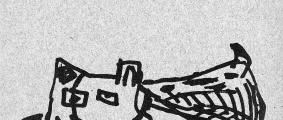
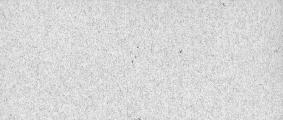


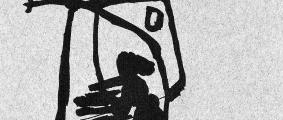
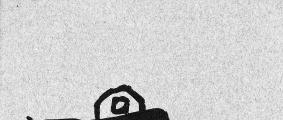










Karel Appel
1956 letterpress 25.9 x 19.0 cm G/1443/1-2 [not shown] purchased from a private owner, 2000
details: catalogue of a 1956 one-man exhibition by Karel Appel in Galerie Rive Droite, Paris, the Stedelijk Museum Amsterdam and the Stedelijk Museum Schiedam. Inventory number G/1443/2 refers to a separate list of works exhibited at the Schiedam exposition, which was held from 28 January to 27 February 1956.
Karel Appel and Emmanuel Looten
Rhapsodie de ma nuit [My Night’s Rhapsody] 1958 lithography on paper and letterpress in cover 33.0 x 25.0 cm
G/103/1-8 [shown only in part] donated by Mr. & Mrs. Sanders, 1958
details: edition number 12/75.
Musique barbare [Barbaric Music] 1963 lithography on paper and gramophone record in book cover various sizes
G/371/1-3 purchased from Karel Appel, 1969






Untitled

1976 lithography on paper 88.5 x 74.3 cm G/2535 donated by the Altena Boswinkel Collection Foundation, 1999
details: edition number 8/110.





